Google Analytics for Audience Insight & Profiling
For anyone new to Google Analytics, or confused by the concept of profiling guests, Clockwork Marketing’s data expert Pete Stevens has some excellent tips to share.
Whether you run a luxury or budget hotel, one thing all successful venues have is an understanding of guests’ needs. A good part of this comes from direct experience, but one of the great advantages of the digital age is that we can discover a heck of a lot about customer preferences by using today’s online tools.
So why is it so important to identify types of guests?
Put simply, today’s guests are individuals who want to feel unique and they expect their visit to your property to me memorable. Some elements of your hotel need to inspire and excite, while other aspects need to be practical and function perfectly. The same is true of your hotel website. Website visitors need to be inspired to book, and to help them do so, the process of booking needs to be as a straightforward as possible.
Understanding the make-up and characteristics of the individuals who browse your website is key to ensuring that the messages and images you use chime with your audience to help inspire them, whether they are young couples looking for action and adventure, or retired guests wanting to experience great cuisine and country walks. Additionally, insight from your visitor demographics can also be used to drive precision targeted digital marketing activity to your website.
So how do you profile your guests?
One of the great benefits of Google Analytics is that it has a set of built-in reports and additional data to help you profile your website visitors in a smart, non-intrusive manner. Those all-important facts and figures that will be relevant for most hotels include their visitors’ age, gender, interests, device usage, time of visit and day of visit. A collection of this data can be used to create website personas for targeting with digital marketing.
Let’s look at the data from one of the hotels we work with; a large beachside hotel, spa and wedding venue.
Age and gender
Website visitors can be split by gender, for our example client, this shows that 59% are female, whereas 41% are male.
Interestingly, most visitors are in the 35-54 age range.
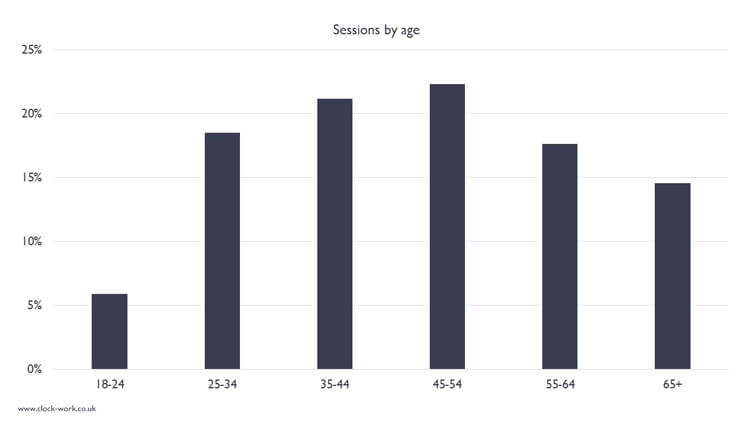
But by combining the gender and age data together a fuller picture emerges.
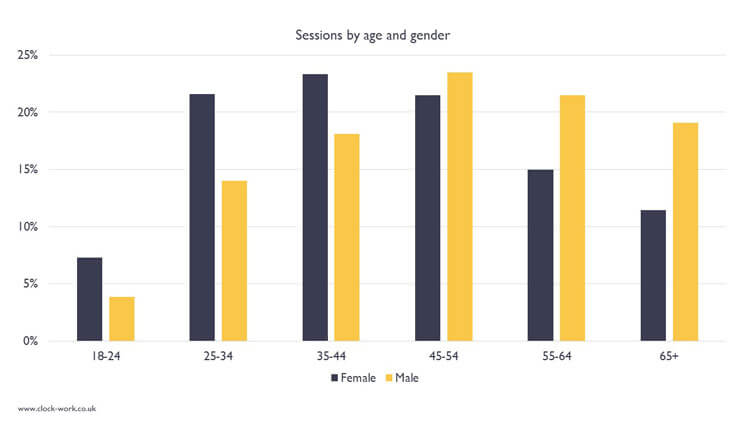
It is now clear that female visitors are younger and male visitors are a bit older.
Device preference
Google Analytics also shows the most used devices for browsing the site, for our example client the results are:
Mobile 39%
Desktop 32%
Tablet 27%
So most people are using mobile? Or is it a pretty evenly split across all 3 devices?
This is where all three dimensions (gender, age and device) can give more insight; female visitors break down into:
18-44 year olds mostly use mobiles.
45-54 year olds use all three devices.
55+ year olds mostly use desktop.
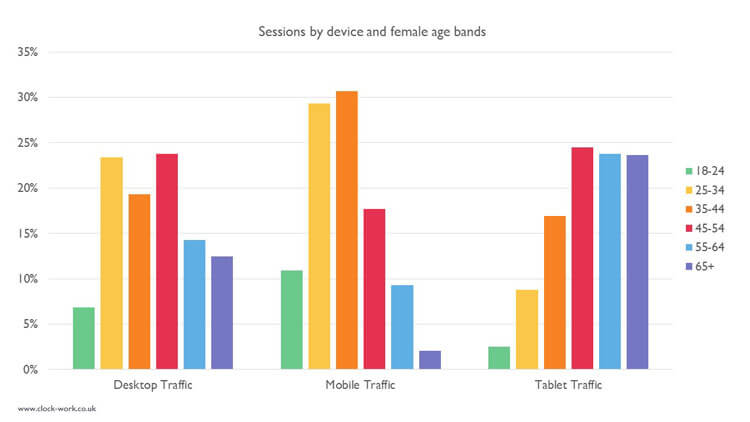
Time of day and day of week
Understanding peak hours is another key metric to help time the delivery of messages. Mapping time of day and day of week data requires the use of custom reports.
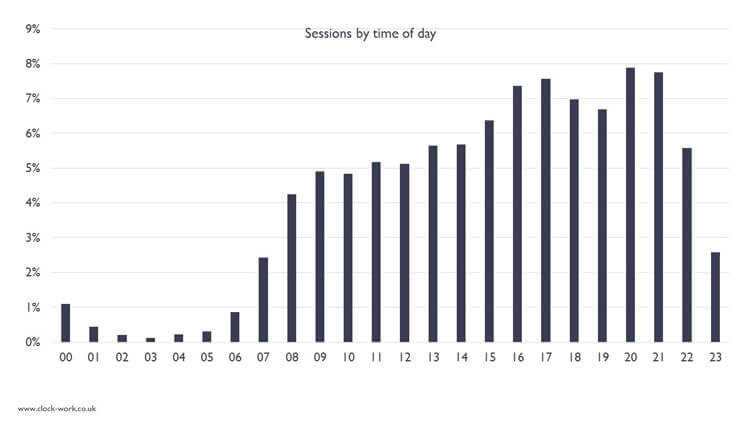
The busiest time for our client’s website is 1500-2100, while the most popular days are Monday and Sunday. This is highly useful information for planning activities such as Facebook posts, tweets and blog entries!
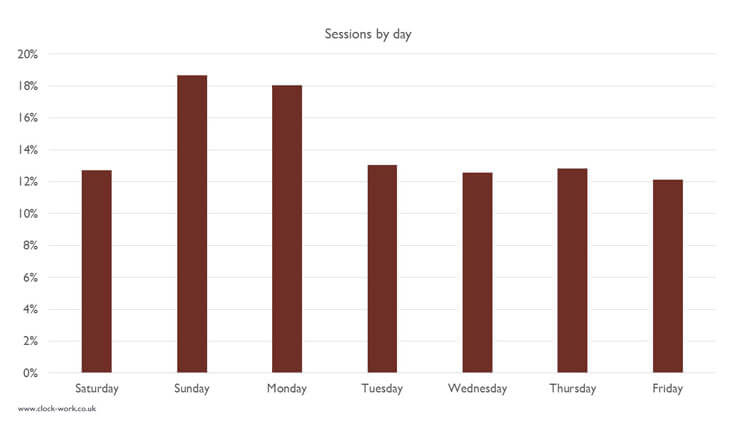
Bringing in other dimensions gives an even wider picture, however. If we include device type, we can see that mobiles and tablets are used later in the day and desktops earlier in the day (mirroring office life).
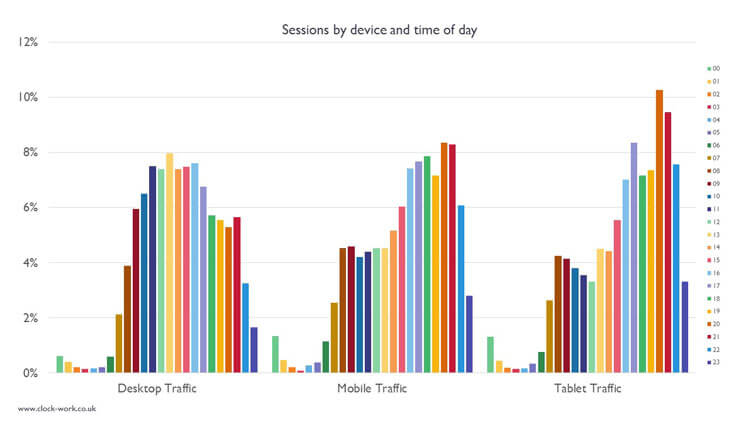
Other demographic information
Turning to affinity categories, some of the top interests for our client’s visitors are:
- Home décor enthusiasts
- Cooking enthusiasts/aspiring chefs
- Outdoor enthusiasts
Other profile data includes location and language. Deeper insight is also available into specific devices used (e.g. Samsung Galaxy S6 or device brand and operating systems).
Using demographic data for marketing success
By this stage you may of course be thinking: “nice stats, but so what?” And unless those numbers are put to work you may have a point, because Google Analytics is only relevant when it can be used to gain meaningful insight that allows you to make actionable business decisions. Hence our priority is not to dig out stats for their own sake, but to use them to develop a clear plan for targeting different customers via email, social and paid advertising.
Paid ads on Google and Facebook both offer many opportunities for targeting specific audiences. All the areas above can be targeted (gender, age, time of day, the day of week, device and affiliate categories). So different ad creatives can be served for several categories of site visitors.

And depending on your email data, this can be segmented by demographics and launched at the peak time when visitors are online. By doing this, there is a much higher likelihood of success and you should expect to see a better ROI on your digital marketing budget.
Of course, creative messages and offers can also be created that match affinity categories and tone of voice can be tailored to appeal to different genders and ages.
Conclusion
By taking the time to understand your website visitors, you can gain a deep insight into their browsing and buying behaviour. This information can be used to create intelligently targeted marketing campaigns to optimise your results with different demographics.
A couple of caveats…
Of course, brilliant though technology is for identifying demographics and trends, there are also areas where the conclusions are less obvious or we have to interpret the data with more care. Examples include people who share devices and have multiple devices. Or specific cases such as an office worker who uses a desktop in work hours before switching to their mobile or tablet in the evening. But unless they are logged in, Google Analytics cannot tie this behaviour together. Similarly, tablets are often shared in households. One user might check the sports results before another looks for home decorating or cooking inspiration. Again, unless the user’s login to different Google accounts, both sessions will be counted as one person.
Last but not least, we must also be careful around data collection. If you are enabling the collection of demographic data in Google Analytics, for example, you may need to amend your privacy policy as you will be collecting personal information.

